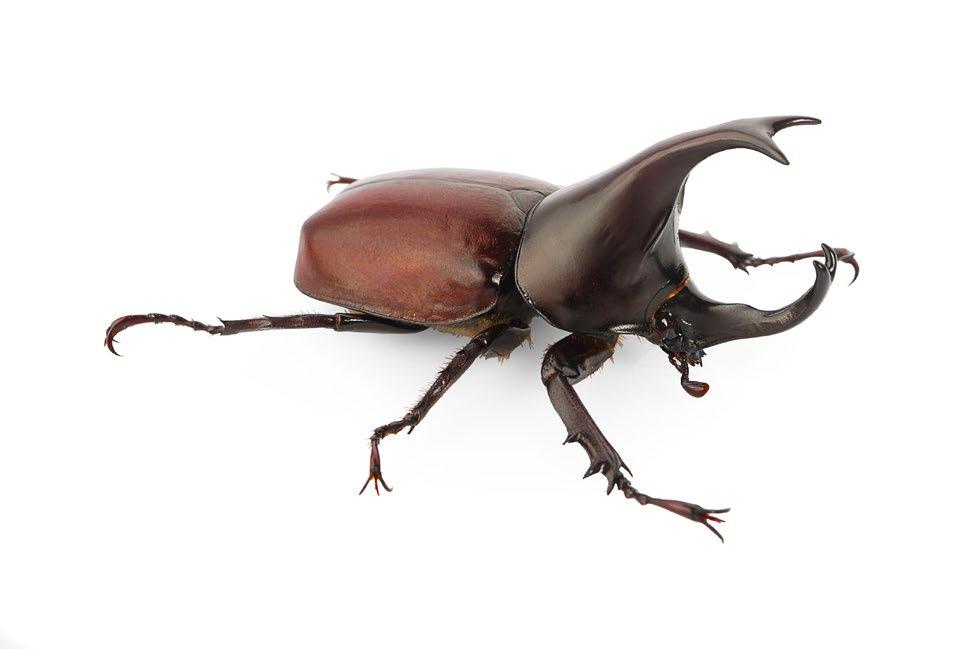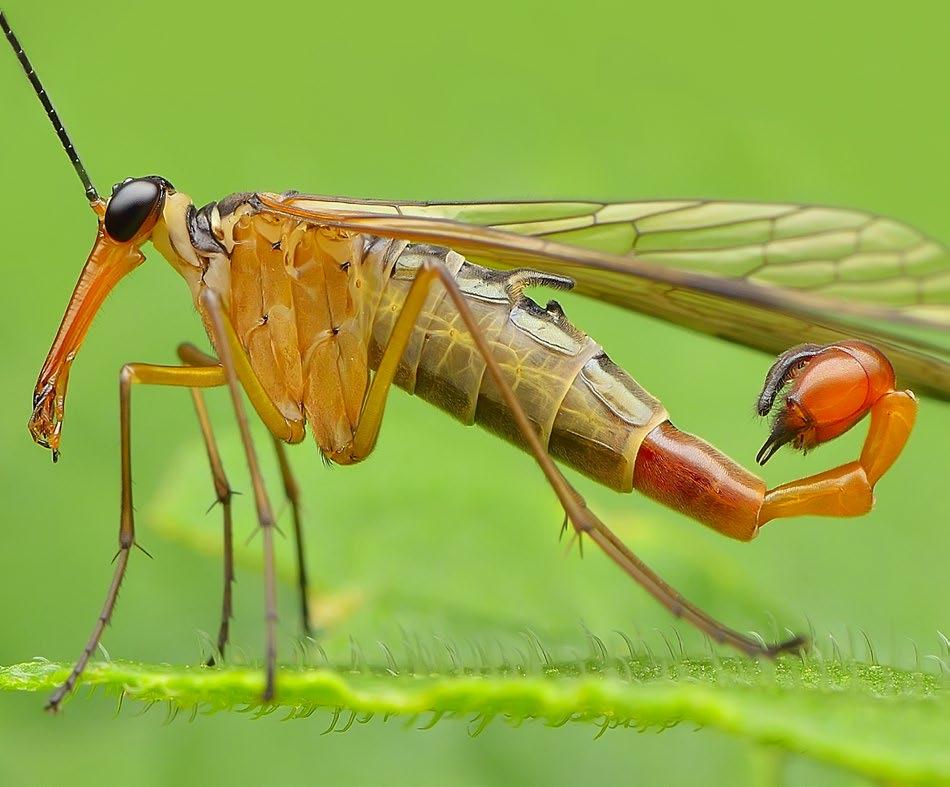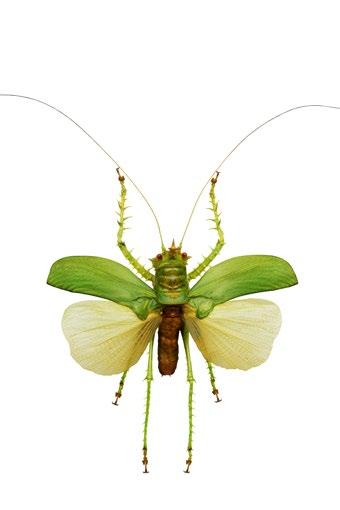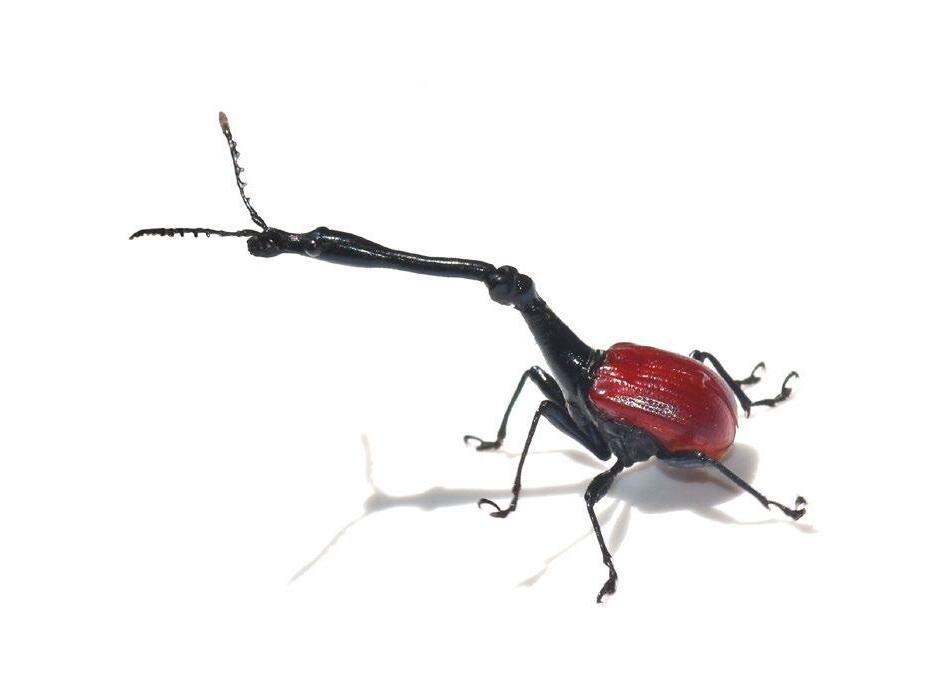

10
GLOW-WORM
SCIENTIFIC NAME: Lampyris noctiluca
makeYes,Ican light! Crazy,right?

SIZE: 2.5 cm (females), 1.8 cm (males)
To make a SIGNAL in the dark, you usually need a light source, don’t you? Well, that’s exactly what the glowworm does to draw attention to itself. The female, who stays on the ground, uses her abdomen to send out intermittent flashes of BRIGHT
YELLOW-GREEN.
She’ll turn on her light for a couple of hours every night until it is noticed by a male flying by, who then uses his own LIGHT SIGNAL to answer her call.
DIET: slugs and snails as larvae; they do not feed as adults.
HABITAT: Europe and north-central Asia, in fields and at the edges of forests.

Haveyoueverseen methisclose?

BIZARRE FEATURE FUN FACT
It uses bioluminescence to search for a partner.
The female has no wings and looks more like a larva than an adult insect.
9 HERCULES BEETLE
SCIENTIFIC NAME: Dynastes hercules

SIZE: 7.1 in (18 cm)
The incredible STRENGTH of this insect justifies its name, borrowed from the hero of Greek mythology. According to some scientists, this animal is THE STRONGEST IN THE WORLD. It can actually carry items up to 850 times its own weight. Males have two horns, one on the thorax and a longer one on the head, which form a “ PINCER” that is one and a half times their body length. When fighting with each other, they can open it up to 4 cm wide, then close it around their opponent’s body and squeeze very hard.
DIET: very ripe or decomposing fruit.

HABITAT: South America, in rainforests.

Going for the “pincer” move, I see... Think again, buddy!

BIZARRE FEATURE
The long horns of the males and their incredible strength.
FUN FACT
Its abdomen changes color when the air is humid: from yellow, or olive green, to black.
8 NUT WEEVIL
SCIENTIFIC NAME: Curculio nucum

SIZE: 7 mm without the rostrum
Why does it need such a STRANGE
SNOUT that is so long and thin? This insect is the sworn enemy of hazelnut plants. With its long hard proboscis, called a ROSTRUM, the weevil sucks the sap out of leaves, making them turn yellow and fall. Females use their rostrum to drill holes through the hazelnut shell. They lay their eggs inside, one for each nut. This will be the birthplace of the LARVA , who then eats the nutritious flesh of the nut to grow and mature.
DIET: hazelnuts as larvae; hazelnut leaves as adults.
HABITAT: Europe, in forests of hazelnut trees.

hereHazelnut, I come!

BIZARRE FEATURE
The thin rostrum of the female is as long as her whole body.
FUN FACT
Its body is covered with thick hairs that are the same color as ripe hazelnuts.
PICASSO BUG
SCIENTIFIC NAME: Sphaerocoris annulus

SIZE: 10 mm
This insect looks like it came out of an abstract painting by an artist with an overactive imagination. Why is it so dressed up? The incredible patterns of color are actually a WARNING SIGN to ward off anyone with bad intentions. They announce that this animal, like many other shield bugs, is extremely SMELLY and it would be best to stay away. If the assailant does not withdraw, the bug falls to the ground and PLAYS DEAD.
DIET: flowers and leaves of various plants

HABITAT: Africa, in tropical savannas

I am Nature’s masterpiece!

BIZARRE FEATURE
Stunning designs and bright colors decorate the body.
FUN FACT
They suck the nectar and sap of many plants by piercing them with a small pointed proboscis.
6
SCORPIONFLY
SCIENTIFIC NAME: Panorpa communis

You can’t help but be afraid! Have you seen my stinger?
SIZE: 3 cm
This bug is a big FAKE! At the bottom of the abdomen, we see a tail ending with a POINTY TIP that the animal curls upward. This position makes it look exactly like the venomous STINGER that all scorpions have. In truth, this is nothing more than a TOTALLY HARMLESS appendage, present only in males, and used exclusively during reproduction, for courting and holding on to their mate.

DIET: nectar, fruit, dead insects.
HABITAT: Europe and North Asia, in hedges and wooded areas.

BIZARRE FEATURE
FUN FACT
The curved tail looks like a scorpion stinger. It often steals leftover food from spider webs.

5 SPINY DEVIL KATYDID
SCIENTIFIC NAME: Panacanthus cuspidatus
SIZE: 3 in (7.5 cm)

At first glance, the spiny devil katydid might seem a bit silly. However, it is actually a CUNNING HUNTER that captures other insects by AMBUSHING them.
Using its long, spiny front legs, it grabs them in a quick, precise strike. If necessary, its ARMED LEGS are also useful for self-defense. The SPINES scattered across its body give it a pretty monstrous appearance, but most importantly, they make it an uncomfortable snack for predators.

DIET: small insects.
HABITAT: South America, in rainforests.

I’mthekingof allhunters!
BIZARRE FEATURE
Spiny armor and a red crown with three points on its head.
FUN FACT
Its bite is powerful enough to cut through human skin.
ORCHID MANTIS
SCIENTIFIC NAME: Hymenopus coronatus
SIZE:
2.4 in (6 cm) (females), 2 cm (males)

This insect is just as BEAUTIFUL as it is DANGEROUS. It actually disguises itself as a flower to lure in unsuspecting insects. When the moment to attack arrives, it grabs its prey with one LIGHTNING-FAST STRIKE of its toothed front legs and quickly turns it into dinner. In addition to looking like a flower, the orchid mantis also acts like one: it attaches itself to a twig and swings back and forth, as if swaying in a light breeze. Some scientists think that the floral dress is also the perfect disguise for hiding from predators.
DIET: small arthropods, especially pollinators.
HABITAT: Southeast Asia, in rainforests.

If you think I’m a harmless little flower, you’re dead wrong!

BIZARRE FEATURE
Body parts that resemble flower petals.
FUN FACT
According to some scientists, the orchid mantis attracts more bees than real flowers do.
3 WATER STRIDER
SCIENTIFIC NAME: Gerris lacustris

SIZE: 1.5 cm
Many people dream of being able to walk on water. The water strider does this with ease, using 4 of its 6 legs to glide across the surface of a pond as if it were ice skating. Why doesn’t it sink? Thanks to two different features! First of all, its legs trap SMALL AIR BUBBLES that work like LIFE RAFTS. Additionally, they are covered with short hairs coated with a waterproof wax that makes them “float”.
I have natural life rafts!

DIET: small animals, dead or alive.
HABITAT: Europe and Asia, on bodies of still water.
IThat’sright, canwalkon water!

BIZARRE FEATURE
Long, thin feet that skate across the water’s surface.
FUN FACT
They can move quite fast, reaching a speed of 15 meters per second (33 miles per hour).
I’m not the cuddly type!
GIRAFFE WEEVIL
SCIENTIFIC NAME: Trachelophorus giraffa

SIZE: 3.5 in (9 cm) (males), 2 in (5 cm) (females)
The most extraordinary feature of the giraffe weevil is, obviously, its incredibly long NECK , which is almost three times longer for the males than it is for the females. The antennae are right at the tip and are used during battle to win the attention of a mate. When fighting, each male sits on a leaf and starts hitting the opponent’s neck in an attempt to knock him down. The long neck is also used for building a NEST to protect young LARVAE .
DIET: leaves... like the mammal it’s named after!
HABITAT: the forests of Madagascar.


BIZARRE FEATURE
Extremely long neck in males.
FUN FACT
When frightened, they play dead and stay still for an hour.
HUMMINGBIRD HAWK-MOTH
SCIENTIFIC NAME: Macroglossum stellatarum
You didn’t confuse me with a tiny bird, did you?

SIZE: 2.2 in (5.5 cm)
At first glance, it isn’t easy to distinguish this large MOTH from the bird of similar name and size, the HUMMINGBIRD! Like the bird, this moth approaches flowers to suck nectar while flapping its wings very quickly. It inserts a very long PROBOSCIS into petals with tubeshaped corollae, remaining SUSPENDED IN FLIGHT for the time necessary to feed on the SWEET NECTAR. Unlike other moths, the hummingbird hawkmoth is active during DAYLIGHT hours, from dawn to dusk.

DIET: nectar from flowers.
HABITAT: Europe, Asia, and North Africa, in forests and meadows.
In-flight refueling completed!

BIZARRE FEATURE
A long proboscis and flight with rapid wing beats.
FUN FACT
They can flap their wings 70-80 times a second, emitting a vibrating hum.
